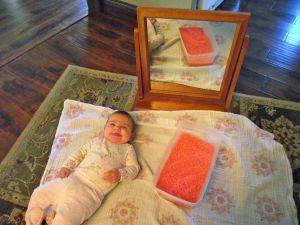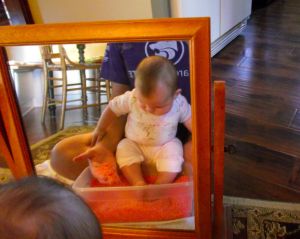After Stella was first born, I spent hours Googling “stay at home mom schedule.” Most of the results that came up seemed unattainable (translation: those moms were way more motivated to do housework than I am), or they otherwise just weren’t quite what I was looking for. Then, I started comparing my stay-at-home-mom schedule to the schedule I had for my infant/toddler classroom when I worked in Manhattan, and it looked nothing like that either. I started to feel like I was failing until, finally, I realized I was being a little bit ridiculous.
If any other parent were to ask me what their schedule should look like, I would tell them that their family is unique and their routine should be, too. It should fit the needs of their particular family and it should be whatever works for them – not necessarily what works for another family. I decided I should probably take my own advice.
One of the most important things to me as a parent is following my baby’s lead. That’s why instead of having a specific daily schedule, we have a basic routine which is eat-play-sleep. That’s the definite part of our routine that we follow every day; the stuff that happens in between each of those basic categories depends on how I’m feeling, what plans (if any) we might have for the day, and, most importantly, Stella’s cues.
We know that babies thrive on consistency and stability, so it can be overwhelming and stressful when you feel like maybe you’re not being consistent enough by, say, sticking to the same rigid schedule every day. I’m here to tell you that you can relax, because rigidity (does anyone else have a hard time pronouncing that word?) isn’t what your baby wants either. Babies want their needs met. Plain and simple. If you try to stick to a very rigid schedule, but your baby gets hungry an hour sooner than you planned, she’s not going to be a very happy camper if you don’t let her eat because you don’t think she’s “supposed” to be hungry yet. She doesn’t understand why, despite her attempts to communicate, you aren’t meeting her needs. Your baby’s sense of stability and consistency isn’t fulfilled through a strict schedule or routine, but more so through the consistent meeting of her needs and the love she feels from you, both of which help her develop a feeling of general well-being.
Sometimes I hold Stella while she naps. Sometimes I feel like I need to get things done, so she naps by herself while I do laundry, shower, or pick up the house (or write this blog post). Usually, she wakes up at 7:30 a.m., but sometimes she doesn’t wake up until 8:30. Her morning nap can range anywhere from 45 minutes to 2 hours. Sometimes she loves playing on a blanket on the floor, and sometimes she would rather be held. My point is, there are a lot of variables in our day. The consistency of Stella’s day lies in knowing that I will always meet her needs and also in her eat-play-sleep routine — when she wakes up, I nurse her and change her diaper, we play or otherwise go about our day (but, I do try to save cleaning, etc. for nap time so most of her awake time is spent playing), she sleeps, and then we start the process over again and continue it until bedtime.
Basically, a baby-led schedule simply involves watching for and responding appropriately and consistently to your baby’s cues — that’s what works best for us and what I believe is best for my baby. What kind of schedule or routine do you find works best for your family? Do you have questions about a baby-led schedule?



